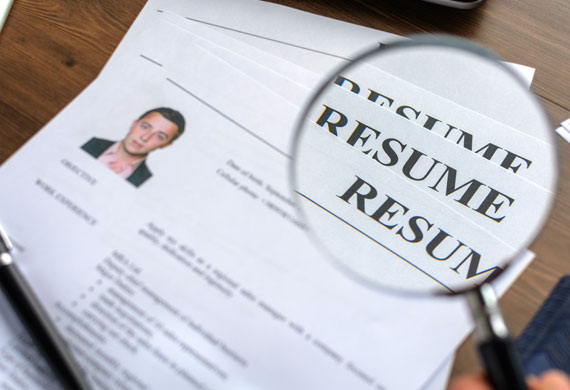Are you ready to stop getting turned down for jobs? Your lacking resume may be the reason you can’t take the next step in your career.
An impactful resume in the hands of a hiring manager can significantly increase your chance to secure an interview. Your resume is a snapshot of your work history, qualifications, and should reflect a history of performance that indicates to the reader your likelihood for success once hired.

clashgraphics.com defines what a resume is, what information should be included, and professional tips on how to properly organize yours.
What Is a Resume?
A resume is a brief summary of your education, skills, and professional background. Resumes may also be used to present accomplishments, volunteer work, certifications, and career objectives.
While the basics of resume writing haven’t changed in decades, new technology fields and online application processes have added dimensions not only to resume content, but also to the hiring process.
How to Write a Resume
The objective of a resume is to present your relevant skills, education, and accomplishments successfully. As your resume may be uploaded at times, a simple one-column format with a professional font may be your best option. However, regardless of the format you choose, the basic information it contains will remain the same.
Basic Information - Every resume should contain the following information relevant to the position or industry you are applying for:
• Contact information including your full name, physical address, email address, and phone number.
• Certifications, licenses, and degrees which add value based on the industry or requirements of the job description.
• Work experience. Whether you begin with your most recent employment or only list relevant jobs, avoid listing every responsibility you had and focus on what you accomplished while in the position.
• Skills and level of proficiency (for example, “basic programming skills” vs. “expert programming skills” or “conversational Brazilian Portuguese” vs. “fluent in Brazilian Portuguese”).
Adding references may seem to be a necessity, but it is not. Only add references or other information if the job posting requires it.
Note: Job postings offer a blueprint as to what should be included in your resume. The addition of unrequested or irrelevant information will likely reduce your chances of being called for an interview.
Resume Examples and Jargon
Sometimes, it helps to see how others write about their experience. Check out these resume samples from the University of Virginia at career.virginia.edu/resumes/creating-your-resume/resume-samples
Are you speaking the same language? - Each industry has its jargon, and before crafting a resume for a specific company, you may want to visit its website or research the industry. By identifying keywords and phrases in relevant example resumes, the company’s website, and the job description itself, you can discover stronger ways to present your credentials and capabilities.
When your resume is posted to an online database, the use of keywords in your titles and text will help potential employers find your resume. It also signals that you are able to speak their language, increasing the potential for a callback.

Order of Information - There is no rule that your work experience should come before your education section. Whatever information is most relevant to the position you are applying for should be at the top of your resume.
If your education or degree is in an unrelated field, move it to the bottom. However, if you lack professional experience and your GPA, degree or overall education are your strongest assets, they should be at the top.
Structure your resume in a way that makes sense for you, your qualifications, and the job for which you are applying.
Resume Visual Format - Avoid leaning too heavily on traditional templates. When your resume is added to a stack of other resumes, what will make it stand out?

Visual communication is as important as the content within the resume. Consider what the employer is looking for and how you can give them what they want to see.
Style your resume so that it appeals to the person reading it, what works for the food and beverage industry may not be appropriate for the engineering industry.
Resume Content Tips
A resume is not intended to include everything you have ever done. Your resume should highlight the most essential skills and experience that is relevant to the positions you are targeting.
The following tips will help you keep your ideas and verbiage simple and easy to read:
Don’t Be Wordy - Busy hiring managers need to understand your experience and qualifications quickly. Use short easy to scan statements vs. long paragraphs. For example:
Wordy and dense: By introducing writing templates and guidelines, I was able to increase article output by 30% and significantly reduce employee time inefficiencies.
Concise: Achieved a 30% increase in article output by eliminating inefficiencies.

Resume Length - A typical resume is one page or two pages maximum. This underscores the importance of being concise and adding only information relevant to what the employer is requesting in the job description.
The job description will always be your guide as to how your resume is constructed. Depending on the company and position you are applying for, you may be required to include much more information using a professional portfolio, learn more here clashgraphics.com/printing-tips/how-to-create-a-professional-portfolio-and-content/
What Are You Applying for? - It is essential that you apply for positions that include work you enjoy doing. If you apply for and include experience for things that you dislike doing, you may end up being hired to perform those tasks.
Keep in mind that even if your experience isn’t directly related to an industry, it may still be highly relevant to the position you are applying for.
Quantify Your Work Experience - Numbers and data help hiring managers to envision your potential impact in their organization. Whenever possible, use real data to increase your credibility and add quality information to your resume. For example:
Unquantified: Increased article output by introducing templates and guidelines.
Quantified: Achieved a 30% monthly increase in article output by reducing research inefficiencies.
Proofread Your Resume - In today’s competitive market, accuracy and quality are critical factors in being successful at anything. A single typo or spelling mistake may be enough to get your resume tossed out early in the vetting process.

Before submitting your resume to employers, proofread it several times line by line, and word by word. Reading it backward will force you to see each word, and it can be a very effective proofreading technique. In addition, have someone else proofread it for you, they may see mistakes or “difficult to read” areas that you cannot see.
Write Your Winning Resume
Catch and hold the attention of hiring managers with an impressive resume, and avoid losing the opportunity to advance your career.
In this article, you discovered the definition of a resume, the information needed in it, and expert tips to accurately organize it.
Without a well-written and presented resume, hiring managers will likely discard your candidacy before you have the opportunity to prove your value. Speak their language and deliver a resume that will make an impression if you’re going to advance your career.
Sources:
https://www.bc.edu/offices/careers/jobs/resumes/howto.html
https://career.berkeley.edu/Tools/Resume
http://www.simmons.edu/cec/undergraduates/career-toolkit/write-a-resume
Clash Graphics Print Shop Atlanta Flyer Printing
2233 Peachtree Rd NE Ste 202 Atlanta, GA 30309
(678) 235-3464
To view the original version on Clash Graphics, visit: https://www.clashgraphics.com/printing-tips/how-to-write-winning-resume/
No comments:
Post a Comment